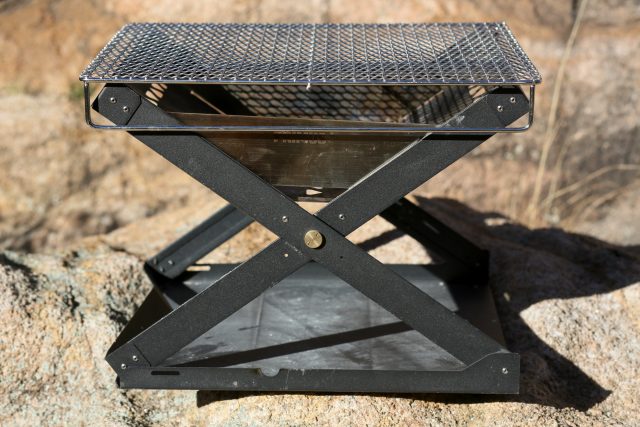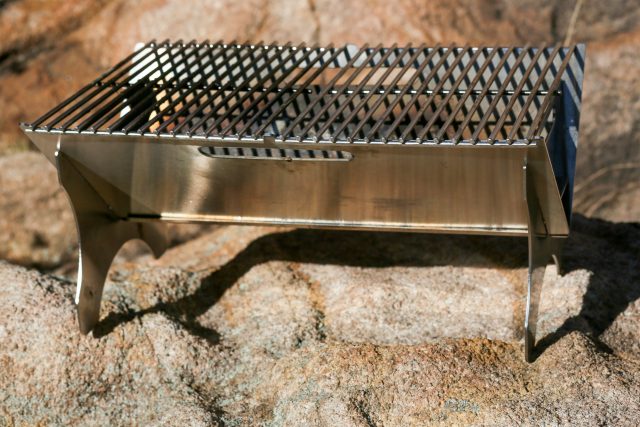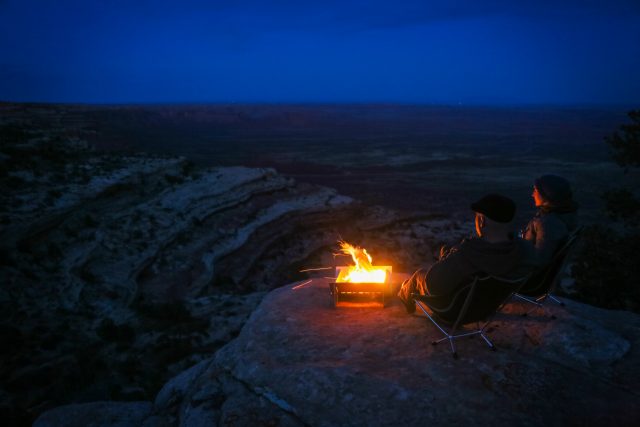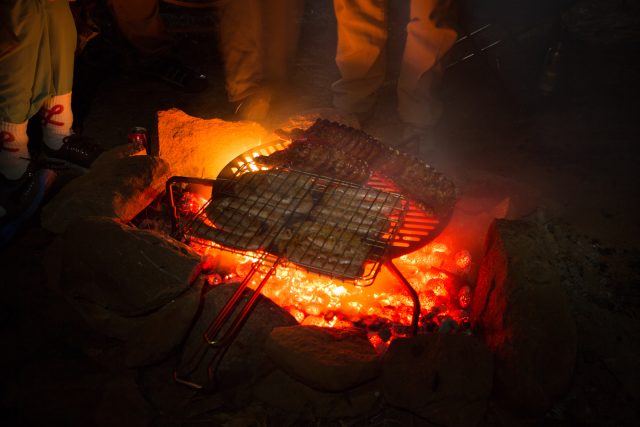Editor’s Note: This fire pits article was originally published in Overland Journal, Summer 2018.
One of my earliest camping memories is of my dad instructing me to police the grounds as we packed up, collecting any trash left by us or anyone that came before. “We need to leave it better than we found it,” was his mantra, and it never wavered. This was also true of our fires, which were meticulously extinguished and double- or triple-checked for even the smallest remaining ember. My dad had a short run as a firefighter, and he was the son of a retired fire captain. Following in line, I was a full-time fireman in the Air Force, much of that time spent as crew chief of a wildfire team. Fire, and trying to keep it from burning things down is just part of my family story. Which brings us to firepits and why they can be an important part of our overland kit.
WHY A FIREPIT MATTERS
There are several scenarios where a firepit is either required or highly advisable, particularly at campsites without an established fire ring or constructed pit. Dispersed camping will often not have a ring of rocks, or authorities may have removed them. As part of a Leave No Trace ethic, we should never build a fire ring due to environmental impact. In some circles, it is recommended to build the fire right on the ground and collect or disperse the ashes once everything cools. This is certainly better than digging a pit and surrounding it with stones, but an ideal solution is to bring along a compact camping firepit.
The firepit also serves other practical advantages, like reducing the likelihood of brush igniting, and making it far easier to collect and dispose of the ash. Functionally, I have also found several of the products to even improve radiant heat and allow the user to sit closer to the flames (ever burned the bottom of your shoes?). By design, pits are also far more fuel efficient, containing the wood and usually funneling the coals and ash to a low point, reducing cold spots or unburnt ends. Practicalities aside, I believe the best advantage of a firepit is cooking. Most of the models have a grill option—perfect for those triggerfish fillets just purchased fresh off the panga.
TESTING AND CONSIDERATIONS
Most of the products in this test are beautifully designed, even surprisingly so, given their intended use. There are a few priorities I settled on after extended use: the product should be rattle-free in the case or able to be dampened with little effort, simple to set up and put away, facilitate funneling of the ash into a container after everything cools, and compact and easy to store. While these considerations seem basic enough, it is shocking how many products on the market fall short of these simple goals. One firepit we considered was the size of a washing machine tub (and likely inspired by it). If the product is too bulky and heavy or is too difficult to set up, it will just collect dust in the corner of the garage. We rated each of these contenders and ranked them against others in the test.
PRIMUS
KAMOTO OPENFIRE PIT | VALUE AWARD
PROS
Good value
Includes a quality grill
Includes an integrated ash tray
CONS
Rattles when stowed
Loose pieces do not nest when put away

A new product for Primus, the Kamoto is designed to accommodate larger logs and includes everything necessary to use the product as a grill. Its sides and base are constructed primarily from powder-coated steel with a brass pivot and stainless rivets; the base serves as a wide ash tray to catch all of the burned material. The hinged end has no lip, which makes pouring the ash into a bin or bag an easy process. Stamped from stainless steel, the fire basin includes aeration holes. The included grill is noteworthy, providing a large cooking surface on the plated steel grating.
Overall, construction and material quality are good, particularly given the reasonable retail price. Assembly takes 35 seconds, but is not entirely intuitive the first time around. There are several loose panels that need to be placed in the correct slots and notches, adding to the complexity of setup. These same pieces can also slide out from the main assembly when folded and made for the most rattles and noise when stored. I used a towel to wrap them up and dampen them, as I did not have the optional storage bag. The Primus works best as a grill and easily accommodates charcoal. The overall weight is 14 pounds (including grill) and stores at just over 2 inches thick when flat. One-year warranty, made in Estonia.
$130/SMALL | PRIMUS.US
SNOW PEAK
PACK AND CARRY FIREPLACE
PROS
Fastest setup
Lightweight
Wide range of accessories, including an oven
CONS
Expensive, dependent upon accessories purchased
Accessories rattle when stored in canvas case
Needs more airflow at base

The Snow Peak fireplace has been around for over a decade and our team has used it consistently throughout that period. The most abused unit shows years of blackening and staining, yet it still folds easily and retains the clean exterior finish of the 1.5-millimeter stainless steel. The Pack and Carry weighs just over 10 pounds and is hinged at all four corners. Setup is fast and intuitive; one movement deploys the legs and firepit at the same time. I have rarely found the optional ash tray to be needed since the aeration vents are high on the sides and only the smallest amount of ash tends to leak past the hinges. The firepit alone packs pretty flat, just over 1.5 inches thick when stored in the included nylon case. There is an optional thick canvas bag which is a more durable option.
Accessories are plentiful but expensive, and when combined in the canvas case, the various pieces do rattle while driving. Options include an ash tray, a cast-iron charcoal tray, fireplace grill bridge, a grill, and even a field oven (yes, for pizza!). There is also a tripod to hang cast-iron cookware and a matching bamboo toolset available, resulting in the ultimate Iron Chef firepit. Limited lifetime warranty, made in Japan.
$150/MEDIUM | SNOWPEAK.COM
STAHL
CAMPER FIREPIT | EDITOR’S CHOICE AWARD
PROS
Elegant design and construction
Good balance of weight and rigidity
High-quality and rattle-free optional case
CONS
Expensive
Sling/case and grill are not included
Coal panel does not nest securely or squarely

A firepit as art, an elegant melding of industrial design with one of the most ancient and elemental of hominid skills—creating and controlling fire. The Stahl Firepit is defined by its minimalism but this does not diminish its usefulness in the field. Constructed from only five plates, four from 1/4-inch, hard-anodized aluminum and one (the coal panel) from equal thickness steel. The lines are intentionally square and blocked, lending to the aesthetic and serving to make an extremely robust product. Aeration slots line the bottom of the pit and the log area is nearly 6 inches deep and over 15 inches wide.
Assembly of the 26-pound Stahl is easy and intuitive, but it does take a few seconds to get the slots lined up and the angles correct for everything to slide together. Once nested, the structure feels like it could withstand several ice ages. Concerns are minimal, mostly centered on the coal panel, which uses only gravity and resistance against the side walls to keep it in place. Machining in a matching angle on the plate would allow it to nest properly and sit level. The Frost River sling is optional ($220), but constructed from leather and waxed canvas, providing a slot for every panel and completely rattle-free transport. An accessory steel grill is also now available for $169. Thirty-day return policy, made in the USA.
$500 | STAHLFIREPIT.COM
FOLD-A-FLAME
STAINLESS STEEL COALBEE DELUXE FIREPIT AND GRILL
PROS
Quality stainless steel construction
Folds flat
Includes canvas carry bag
CONS
Heavy
Accessories rattle when stored in canvas bag
Charcoal grate tight to install or remove
Needs more airflow at base

Fold-A-Flame’s business centers on making firepits and their website is complete with products and accessories supporting a few of their flat-packing models. Constructed from 1/8 inch stainless steel, the entire assembly is only 1 inch thick when stored in the supplied canvas bag. There are five plates that are precision cut, notched to assemble without tools in about 30 seconds. It takes a few tries to get the balance of the first few pieces right as they slide together, and the charcoal grill is particularly tight, making it difficult to install or remove and align with the opposite side slot. Everything fits so snug that little airflow is brought into the lower levels of the pit, which can make it difficult to keep coals lit.
Once assembled, the unit is impressively sturdy and the two piece grill is convenient for managing grilling and warming duties. With both grills in place, it has by far the largest overall surface area for cooking in the test. My only significant complaints surround the overall weight of the unit at 30 pounds and the lack of dividers or dampers in the canvas bag. The quality of this kit cannot be overstated and the Fold-A-Flame should last many lifetimes. One-year warranty, made in the USA.
$419 | FOLDAFLAME.COM


Read more:



4 Comments
Ben
February 20th, 2019 at 5:11 pmAnother alternative is a propane fire pit! While they certainly have their drawbacks and lack that wood burning aroma there is fewer concerns of starting a wildfire and I tend to have a 10 pound propane tank on hand regardless. I now use it on almost all my trips and the more and more I camp and backpack I tend to forgo a camp fire altogether.
Richard E Hobbs
February 20th, 2019 at 5:42 pmI have recently been looking for a portable fire pit and appreciate your review. I too looked at all of these and came to much the same conclusion. I found a inexpensive option that seems to do the job for $120 including a heat shield – the pop-up pit. It’s easy to store, lightweight aluminum and well designed. It’s sold on amazon and has really good reviews. It arrived in the mail today and I haven’t yet tried it but am excited to try it. Pop-up pit could be a good addition to the list and a review here would be great. Thank you.
Hayden
February 21st, 2019 at 9:00 amJust a note, I think you may have accidentally left out the blurb for the “Editor’s Choice” fire pit.
Atsushi
March 13th, 2019 at 2:35 amGreat article! I’d love to see the Kovea Magic 2 Upgrade Stainless BBQ included as well! I believe it is intended to be a BBQ but it functions perfectly as a fire pit with the cooking grill removed. It’s lightweight, folds compact into a nice canvas bag, rattle free when stowed, and an amazing price point. Take a look when you get a chance… I love mine.